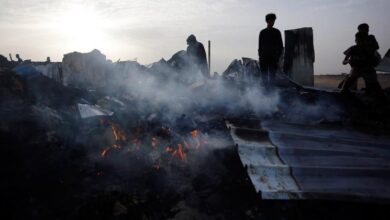Inside the world’s first broadcaster for and by people with learning disabilities
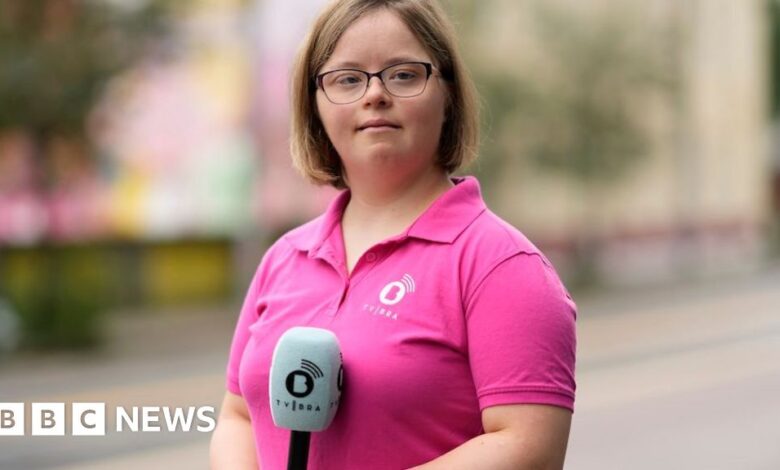
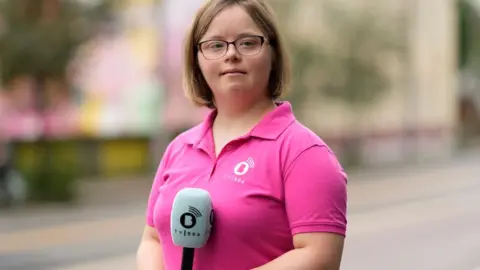 television bra
television braPerhaps it’s no surprise that TV BRA’s new studio décor is shockingly pink.
It’s the favorite color of two of the station’s reporters, Emily Ann Riedel – who was wearing pink when I visited – and Petter Bjørkmo. “I even have pink hair!” Bjørkmo told me with a laugh before adding that he had to get rid of it “because I’m a reporter — reporters have to look presentable.”
All reporters at TV BRA – which stands for “TV Good” – are disabled or autistic; most have learning disabilities.
Every week they put together a one-hour magazine show covering news, entertainment and sports, which is broadcast on Norway’s major streaming platform, TV2 play, as well as the app and website TV BRA’s own.
‘I have inner beauty and outer beauty’
The program is presented in Norwegian which is simpler and slower than the mainstream news, making it much easier to follow. About 4,000 to 5,000 followers per week.
The station’s 10 reporters are scattered across the country, where they work as local news reporters.
Riedel, who has Down Syndrome, lives and works in the coastal city of Stavanger. She had to learn to control her explosive personality.
“I have to follow the script and not talk about personal things – because this is about the news. When working here I have to be very professional.”
Even though she’s worked at the station for years, some things are still new, like the mascara she applies before going on camera and which she says makes her eyelids feel heavy.
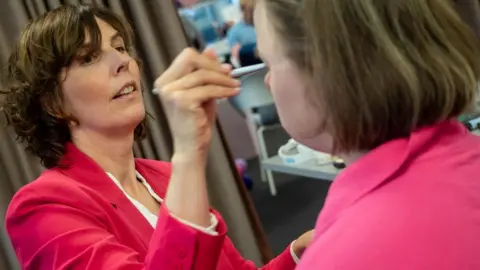
Riedel smiled and told me: “I don’t need it because I look good. “I have inner beauty and outer beauty.”
“That’s right,” chuckled Camilla Kvalheim, the station’s managing editor — and now a makeup artist. “But in the studio, with the heavy lights and everything, you look paler.”
Kvalheim and a small non-disabled technical team produce and edit all reports.
Although Riedel and her colleagues have mild learning disabilities – they can mostly speak English well and travel without assistance – some things are still a challenge.
I watched the group try to get used to the new automatic signaling system. Presenters often have to read a line many times to understand it.
“Sometimes it’s hard to tell what’s on the cue card, so we have to do it over and over again,” Kvalheim said. She also had to provide on-the-job training to her team, who had not studied journalism at university before joining the TV station.
However, her expectations for her team are high.
“She said: ‘Can you please do that again? Can you repeat what you said? Can you look straight at the camera, I want you to be perfect – this is very important,’” Riedel said.
“And when she was proud, when we finished, she said, ‘I love this part! I love this part! That’s what I want to see! Use your energy to be the best you can be!’”
It has been pointed out that people with learning disabilities can be hindered by overly positive feedback, which prevents them from developing their skills. That’s not an issue here.
“If we want to be seen by the audience, we have to look professional,” Kvalheim says unapologetically. “If they want to be respected as reporters and journalists, they need to adhere to the ethical standards of other news organizations.”
TV BRA’s origins began more than a decade ago, when she was working as a teacher for people with learning disabilities at a nursing home in Bergen and decided to pursue her passion for filmmaking. She noticed that as soon as she took out her camera, the dynamic between her and the people she worked with changed.
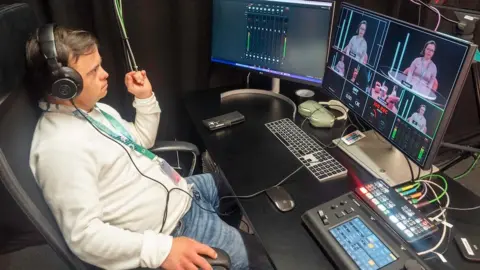
“Suddenly when we worked together on those movies, we were a crew, we were a team. It wasn’t that I was better than them – we were equal,” Kvalheim recalls.
Realizing that her creative collaborators had much to say about the world, she was encouraged to continue her work and it gradually gained momentum.
It’s now a national network, with a studio to match – but Kvalheim admits that her reporters aren’t paid the same as their colleagues at other networks.
The station receives state funding and has revenue from providing weekly programming to TV2 but funding is extremely tight.
So it’s good that the team is motivated by things other than money. In Norway, as in every country, people with learning disabilities face problems ranging from low employment rates to access to support and housing. Being able to understand the news helps the wider community to mobilize on these issues.
‘Talk about rights’
A recent report by Petter Bjørkmo is a case in point. He visited a woman with a more severe learning disability who lived in temporary housing in Trondheim. “The city — the government — wants to take away her ability to shop,” he told me, meaning her budget would be accompanied to the stores by an assistant.
“They told her she had to go online. But she can’t! Because she doesn’t speak well, it’s difficult for her to go online to buy food. She needs help!
Bjørkmo’s report received a “huge reaction” from viewers, Kvalheim said, although it did not cause local authorities to rethink their position.
“TV BRA is very important,” agreed Svein Andre Hofsø, another reporter. “Because we’re talking about people with disabilities and what our rights are in real life.”
Hofsø, a roving news reporter based in Oslo, was famous even before joining TV BRA.

He took on the lead role in the 2013 film, Detective Downs. Before the most recent parliamentary elections, in 2021, Andre again had the opportunity to don his detective fedora hat, but this time his job was to question various politicians about their policies according to his joking style.
One such scene shows him sitting on a bench outside the parliament building in Oslo, pretending to read a newspaper. A politician, Jonas Gahr Støre – leader of the Labor Party – is walking outside but behind a pillar, a scarecrow is lurking to ambush him. As Hofsø watched, the giant threw the butterfly net at Støre without suspicion.
In the next scene, we see Støre sitting in a chair in the basement. Hofsø shined a slanted light in his face and showed him pictures of disabled people looking sad and lonely. “If we vote for you, what will you do for us?”
At this time, Støre introduced its policies for people with disabilities. And after the election, he actually became prime minister.
Camilla Kvalheim laughed as she recalled the encounter. “That’s funny. From then on, every time we saw him, he said, ‘Oh — are you going to catch me in that butterfly net?!’”
On the day I visited TV BRA, they were visited by Silje Hjemdal, a local lawmaker from the right-wing Progressive Party.
A group of four reporters asked her about everything from roads to immigration, and what she thought about plans for a lavish new national theater in Oslo (being from Bergen, she had some doubts about the project). judgment). Kvalheim was also there, directing the questions.
Hjemdal’s answers were serious but there was also warmth in the encounter; she is a long-time supporter of the station. “A lot of politicians now know what TV BRA is, so I would say it’s a big step forward, just in the last five years,” she told me.
‘Doing TV in a new way’
TV BRA is not the only television news station presented by people with learning disabilities. Similar, albeit smaller, programs also exist in Iceland and Denmark. Meanwhile, Slovenia, the Netherlands and several other countries offer “easy news” services – simplified reports, although people with learning disabilities cannot present them.
For BRA TV viewers, this type of service is essential. Anne-Britt Ekerhovd, who is a fan of the station and has a learning disability, said: “I think this broadcaster is really important for our community. “They explain everything very clearly. In other news like NRK, they explain it too confusing for us. TV BRA is much easier to understand.”
Another fan of the station, Espen Giertsen, agrees: “There is something special about this – they are making TV in a new way.”
TV BRA reporters are very aware of the important role they play in serving this often overlooked audience.
“If they have a ton of burden on them, I want them to lift it so they can be free, so they can feel like they’re accepted,” Emily Ann Riedel said.

People Fixing the World – Pioneering television news service
TV BRA in Norway is a unique media organization. Their fortnightly national news program is presented by reporters with learning disabilities or autism.
Through interviews with politicians and other authority figures, the station aims to hold those in power to account, while changing the way people with learning disabilities are viewed.
Our reporter William Kremer joins them in their flashy new studio in Bergen, where the journalists share some of their best stories and tell us about their aspirations for the future.


